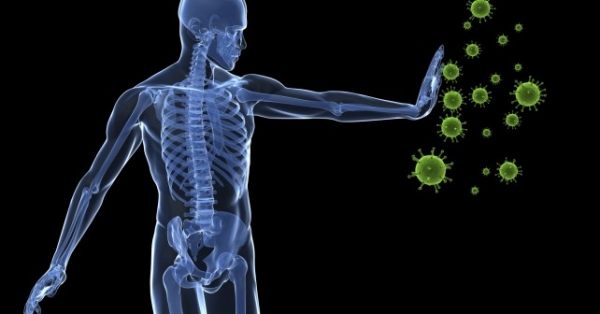
What is immune system? This is a very ancient evolutionary thing that occurred in nature before the separation of plants and animals in the Kingdom, since plants have their own immune system, and, of course, it is the animals. The main function of this system is to protect from intrusion, that is, protection against infections, infestations, parasites, germs. This can be attached and the reaction to the allergen is also one of the parts of the immune system, but the priorities of the immune system — fight with a stranger.
For this purpose in the immune system there are many branches, and, in particular, the entire immune system can be divided into innate and adaptive, or acquired. They differ on a very simple criterion: innate immunity does not require any training of the immune system, she is seeing someone else (and what she sees is a separate story), reacts immediately. But in innate immunity there is no concept of memory, as any new invasion she will be responsible in the same way as the previous one. Adaptive immunity is a more recent thing in the evolution, and adaptive, which adapts to the invasion of the parasite, the host begins to react. The first time he responds slowly and weakly, and with repeated contacts, he has already trained its receptors are configured for this type of invasion, and the owner reacts stronger and more effective. Are two branches of immunity.
The immune response developed in special organs of the immune system — in lymph nodes and spleen, but that these bodies were stuffed by cells of the immune system, they need to go there. And they come from the same source — bone marrow. In the bone marrow of animals are born from precursors of all cell types of the immune system, some are already ready for operation form, for instance such cells as neutrophils, which go into the blood from bone marrow monocytes which go into the blood from bone marrow, and then in the bodies can transform into macrophages, another type of cells phagocytosis. And of course, there are the lymphocytes, primarily engaged in (almost all types of lymphocytes, but not all) adaptive phase, and they are trained. This is especially true of such cells as T-lymphocytes, which, after leaving the bone marrow, enter another Central organ of the immune system — the thymus.
Thymus — the thymus is such that education which lies at the heart of is right in srednestan and there is absolutely wonderful in its subtlety and precision work on the selection of T-lymphocytes for subsequent functioning as cells of the immune system. There kills all lymphocytes, which might be overreacting on this one, cos from the bone marrow come cells, that can react on their own, and on someone else’s. But in the thymus is negative, the negative selection of those T cells that react too strongly on their own, and those T cells that recognize someone else’s bad. And in the thymus are killed 95% of the incoming cells. The remaining 5% out to the periphery in the lymphatic system, colonize the spleen and lymph nodes and are there ready to receive the received signal from the cells that initially come into contact with, for example, a microbe, a virus. And then deliver this material to the lymphocytes, which either starts to produce antibodies if it’s B-lymphocytes, or direct contact with phagocytes and produce a variety of mediators of immunologically active molecules that assist the host to combat the parasite. And in varying degrees, such a system appears in evolution roughly with fish and have constantly improved and comes to the higher mammals, in particular humans. In lower animals and plants the immune system is designed differently, and there is innate immunity is much more important than adaptive. We have approximately equitable.
Of course, not to mention the function of the immune system as fighting tumors. Unlikely it was evolutionary, as directly primary!!! Most likely, evolution actually selects all that useful. Most likely, the system that was developed to fight with a stranger, was expressed in some degree prepared to fight with her, which was reborn. This is the fight against tumors. In this aspect, there are cells of innate immunity, the so-called natural killer cells (or natural killer cells) are cells that can react with tumor cells and directly destroy it. Are the cells of an adaptive system, some T cells, and this is a big and important part, it is able to destroy the tumor, acquiring immunity to tumor antigens. It is, however, not as effective as immunity against microbes, but nevertheless, apparently, saves us in very many cases, without the intervention of medicine. Just like this built-in mechanism.
The immune system works with different types of pathogens in different ways. If pathogens are extracellular and are, for example, commonplace for all of us streptococci, staphylococci, enteric infections, there are primarily cells of the innate immunity, which simply phagocytose and destroy the germ, and produce beta-body B-lymphocytes. The cells of the adaptive immune system and their main function is antibodies to pathogens. And there are, of course, a very large group of intracellular pathogens, primarily viruses. In the second place it is quite many types of bacteria and protozoa. In particular, these include Mycobacterium tuberculosis (the subject of my specialization), which antibodies do not act at all, because most of the life cycle they are inside host cells, so from the outside to get there just can’t. Or even an attempt to neutralize these pathogens, the methods, which are suitable for extracellular microbes, lead to unpleasant consequences.
In particular, the excessive influx of neutrophils in the lesion of intracellular infection may cause purulent inflammation, but it is not able to cope with a microbe, which sits, for example, inside the macrophages, which even exceeds the size of a neutrophil, which is not able to absorb simply by definition. Primary phagocytosis but very, very effective against fast acute conditions. There it is absolutely necessary. The main active principles of immunity are the phagocytes, the lymphocytes and their products — antibodies, cytogeny that activate other cells in the immune system are helper molecules. For example, there is the compliment system, which helps the toxic effects of antibodies against pathogens.
What else there are two systems of immunity? They are very different to those receptors that recognize the invasion. Cells of innate immunity are on the surface of several families of receptors that directly seeing the parasite. And the cells of the adaptive immune system have a very complex system of receptors, which upon infection undergo complex structural adjustment and be specific to this type of infection.
Immunology is developing very quickly, and in addition to these inevitable in science aspects as description of new molecules, an attempt to classify everything and everyone than science is always sin, and there are real breakthroughs. In particular, we have only just started gradually, after the 1990 and 2000-ies, to understand what is the link between the ancient innate immune system and much more new evolutionary adaptive. Now this is probably, one of the hotspots of immunology: as signals from one system recognition go to another recognition system and how it all orchestrierung, in a concert of works against diseases.
Alexander Apt – doctor of biology, Professor of immunology, biological faculty, Moscow state University, head of the laboratory of immunogenetics of the Russian Academy of medical Sciences







